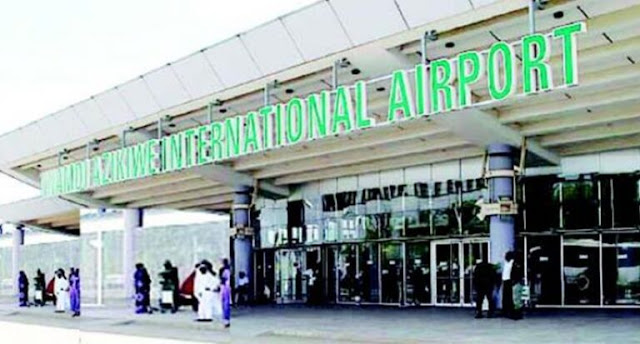In a landmark move to align Nigeria’s aviation sector with global climate action targets, the Federal Government has unveiled an ambitious plan to decarbonize Nnamdi Azikiwe International Airport (NAIA) in Abuja. This initiative, spearheaded by the Ministry of Aviation and Aerospace Development in collaboration with the Federal Airports Authority of Nigeria (FAAN), represents a significant step toward embedding sustainability into the nation’s aviation infrastructure. By prioritizing electrification, sustainable aviation fuel (SAF), and waste-to-energy projects, the government aims to drastically reduce emissions and achieve net-zero operations, setting a precedent for environmental stewardship in Nigeria’s aviation industry.
The announcement was made during a stakeholders’ engagement on carbon emissions management at NAIA, organized by FAAN. Representing the Minister of Aviation and Aerospace Development, Festus Keyamo, the ministry’s Permanent Secretary, Ibrahim Kana, emphasized the urgency of addressing climate change, describing it as a “present and pressing reality” that demands immediate and coordinated action. The initiative is not only a response to global environmental challenges but also a strategic effort to ensure the long-term resilience and prosperity of Nigeria’s aviation sector. As the country positions itself as a leader in sustainable development in Africa, the decarbonization of NAIA is poised to serve as a model for other airports across the nation, including those in Kano, Enugu, and Port Harcourt.
The Imperative of Climate Action in Aviation
The aviation industry, while a critical driver of global connectivity and economic growth, is also a significant contributor to greenhouse gas emissions. Globally, aviation accounts for approximately 2-3% of carbon dioxide emissions, a figure that is expected to rise as air travel demand grows, particularly in emerging economies like Nigeria. Recognizing this, the Nigerian government has taken a proactive stance, aligning its aviation policies with international frameworks such as the Paris Agreement and the International Civil Aviation Organization’s (ICAO) Carbon Offsetting and Reduction Scheme for International Aviation (CORSIA).
During the stakeholders’ engagement, Ibrahim Kana, speaking on behalf of Minister Festus Keyamo, underscored the critical need for sustainability in Nigeria’s aviation sector. “The challenge of climate change is not a distant theoretical concern; it is a present and pressing reality that demands decisive, concerted action,” he stated. He highlighted that embedding sustainability into the core of Nigeria’s aviation infrastructure is not merely an option but an imperative for ensuring long-term resilience and prosperity. This commitment reflects Nigeria’s broader ambition to contribute to global climate goals while fostering economic growth and job creation through sustainable practices.
The decarbonization of NAIA is a cornerstone of this vision. As one of Nigeria’s busiest airports, NAIA serves as a critical hub for both domestic and international travel, making it an ideal starting point for implementing transformative environmental policies. The initiative is expected to reduce the airport’s carbon footprint significantly, enhance operational efficiency, and position Nigeria as a leader in sustainable aviation in Africa.
Key Components of the Decarbonization Plan
The decarbonization strategy for NAIA is multifaceted, focusing on three key pillars: electrification of airport facilities, adoption of sustainable aviation fuel (SAF), and implementation of waste-to-energy projects. These measures are designed to address the major sources of emissions at the airport while promoting innovation and sustainability.
1. Electrification of Airport Facilities
One of the primary sources of emissions at airports is the use of fossil fuel-powered equipment and vehicles, particularly on the apron and in terminal operations. To address this, the government plans to transition NAIA to electric-powered systems wherever feasible. This includes the electrification of ground handling equipment, such as baggage carts, pushback tugs, and passenger shuttles, as well as the installation of energy-efficient lighting and HVAC systems in terminals.
Electrification is expected to significantly reduce the airport’s reliance on diesel and gasoline, which contribute to high levels of carbon dioxide and other greenhouse gas emissions. By leveraging renewable energy sources, such as solar power, to support these electric systems, NAIA can further minimize its environmental impact. The government has already begun exploring partnerships with private sector stakeholders to develop solar farms and other renewable energy infrastructure to power the airport’s operations.
2. Adoption of Sustainable Aviation Fuel (SAF)
Sustainable aviation fuel (SAF) is a critical component of the decarbonization strategy. Unlike conventional jet fuel, SAF is produced from renewable feedstocks such as agricultural waste, used cooking oil, and algae, resulting in significantly lower lifecycle carbon emissions. The adoption of SAF at NAIA is expected to reduce emissions from aircraft operations, which account for a substantial portion of the airport’s overall carbon footprint.
The Ministry of Aviation and Aerospace Development is working to establish SAF corridors, which will involve collaboration with airlines, fuel suppliers, and international partners to ensure a steady supply of sustainable fuel. This initiative aligns with global trends, as airlines worldwide are increasingly adopting SAF to meet their emissions reduction targets. For Nigeria, the development of SAF infrastructure also presents an opportunity to stimulate economic growth by creating new supply chains and jobs in the bioenergy sector.
3. Waste-to-Energy Projects
Waste management is another critical area of focus in the decarbonization plan. Airports generate significant amounts of waste, including food scraps, packaging materials, and other refuse, much of which ends up in landfills, contributing to methane emissions. To address this, NAIA will implement waste-to-energy projects that convert organic and non-recyclable waste into usable energy, such as biogas or electricity.
These projects not only reduce landfill waste but also provide a sustainable source of energy for airport operations. By integrating waste-to-energy systems, NAIA can create a circular economy model, where waste is transformed into a valuable resource. This approach is expected to serve as a blueprint for other airports in Nigeria, promoting sustainable waste management practices across the aviation sector.
Lessons from Murtala Muhammed Airport
The decarbonization plan for NAIA builds on lessons learned from similar initiatives at Murtala Muhammed International Airport (MMIA) in Lagos, Nigeria’s largest and busiest airport. FAAN Managing Director Olubunmi Kuku, represented by the Director of Human Resources and Administration, Luqman Eniola, noted that electricity consumption accounted for approximately 90% of emissions recorded at MMIA between 2017 and 2023. In response, FAAN introduced several emission-reduction measures, including energy-efficient lighting, solar-powered systems, and optimized operational practices.
These efforts have yielded measurable results, reducing MMIA’s carbon footprint and providing valuable insights for the NAIA initiative. For example, the transition to energy-efficient technologies at MMIA demonstrated the potential for significant cost savings, as well as environmental benefits. By replicating and scaling these measures at NAIA, FAAN aims to achieve similar success while tailoring the approach to the unique needs and infrastructure of the Abuja airport.
Kuku emphasized FAAN’s commitment to sustainability, stating, “We want to walk with you in our determination to achieve net-zero emissions in our airport operations.” Her remarks underscored the collaborative nature of the initiative, which involves partnerships with government agencies, private sector stakeholders, airlines, and international organizations. This collective approach is essential for overcoming the financial, technical, and logistical challenges associated with decarbonization.
A Blueprint for Nationwide Implementation
The decarbonization of NAIA is not an isolated project but part of a broader strategy to transform Nigeria’s aviation sector. The government plans to replicate the initiative at other major airports, including those in Kano, Enugu, and Port Harcourt. By establishing NAIA as a model for sustainable airport operations, the Ministry of Aviation and Aerospace Development aims to create a scalable framework that can be adapted to airports of varying sizes and capacities across the country.
This nationwide approach is a key component of Nigeria’s broader climate resilience strategy, which seeks to address the impacts of climate change on critical infrastructure and industries. The aviation sector, as a vital economic driver, is particularly vulnerable to climate-related disruptions, such as extreme weather events and rising sea levels, which can affect airport operations and connectivity. By investing in sustainability, the government aims to enhance the sector’s resilience while contributing to global efforts to combat climate change.
The initiative also aligns with Nigeria’s commitments under the Paris Agreement, which include reducing greenhouse gas emissions and transitioning to a low-carbon economy. By prioritizing sustainable aviation practices, Nigeria is positioning itself as a leader in the African continent, where many countries are grappling with the dual challenges of economic development and environmental sustainability.
Stakeholder Engagement and Collaboration
The stakeholders’ engagement on carbon emissions management at NAIA was a critical step in building consensus and fostering collaboration. The event brought together representatives from government agencies, airlines, environmental organizations, and private sector partners, all of whom play a role in achieving the decarbonization goals. Discussions focused on practical steps for implementation, including funding mechanisms, technological innovations, and policy frameworks.
One of the key outcomes of the engagement was the recognition of the need for public-private partnerships (PPPs) to drive the initiative forward. Decarbonizing an airport of NAIA’s scale requires significant investment, as well as expertise in areas such as renewable energy, waste management, and sustainable fuel production. By partnering with private companies and international organizations, the government can leverage additional resources and expertise to accelerate progress.
The engagement also highlighted the importance of raising awareness among airport users, including passengers, airlines, and ground handling companies. Educating stakeholders about the benefits of sustainability and encouraging their participation in emission-reduction efforts will be crucial for the initiative’s success. For example, airlines can be incentivized to adopt SAF through tax breaks or subsidies, while passengers can be encouraged to support eco-friendly practices, such as recycling and carbon offsetting.
Challenges and Opportunities
While the decarbonization plan is ambitious, it is not without challenges. The high upfront costs of transitioning to electric systems, developing SAF infrastructure, and implementing waste-to-energy projects may strain government budgets, particularly in a developing economy like Nigeria. Additionally, the aviation sector faces technical challenges, such as the limited availability of SAF and the need for specialized equipment to support electrification.
However, these challenges also present opportunities for innovation and economic growth. The development of SAF supply chains, for instance, could create jobs in agriculture, bioenergy, and logistics, while also reducing Nigeria’s reliance on imported fossil fuels. Similarly, investments in renewable energy infrastructure, such as solar farms, could provide a reliable source of clean energy for airports and surrounding communities.
The initiative also offers an opportunity to showcase Nigeria’s commitment to sustainability on the global stage. By leading the way in decarbonizing its aviation sector, Nigeria can attract investment, strengthen its reputation as a forward-thinking nation, and inspire other African countries to follow suit.
The Broader Context: Climate Change and Aviation
The decarbonization of NAIA must be viewed within the broader context of climate change and its impact on Nigeria. The country is highly vulnerable to climate-related risks, including flooding, desertification, and extreme weather events, which threaten livelihoods, food security, and infrastructure. The aviation sector, as a critical component of Nigeria’s economy, is not immune to these risks. Rising temperatures and unpredictable weather patterns can disrupt flight schedules, damage airport infrastructure, and increase operational costs.
By addressing these challenges proactively, the government is taking a significant step toward building a more resilient aviation sector. The decarbonization plan is not only about reducing emissions but also about ensuring that Nigeria’s airports can continue to operate effectively in the face of climate change. This resilience is particularly important for a country like Nigeria, where air travel plays a vital role in connecting urban centers, facilitating trade, and promoting tourism.
Looking Ahead: A Sustainable Future for Nigerian Aviation
As Nigeria embarks on this transformative journey, the decarbonization of NAIA represents a bold vision for the future of aviation in the country. By prioritizing sustainability, the government is not only addressing the immediate challenges of climate change but also laying the foundation for a more resilient, efficient, and competitive aviation sector. The success of this initiative will depend on strong leadership, robust partnerships, and a commitment to innovation.
Looking ahead, the government plans to monitor and evaluate the progress of the NAIA decarbonization project, using data and feedback to refine and improve the approach. Lessons learned from NAIA will inform the rollout of similar initiatives at other airports, creating a ripple effect across the country. The ultimate goal is to achieve net-zero emissions across Nigeria’s aviation sector, contributing to global climate goals while driving economic growth and development.
Conclusion
The Federal Government’s plan to decarbonize Nnamdi Azikiwe International Airport is a groundbreaking step toward a more sustainable future for Nigeria’s aviation industry. By focusing on electrification, sustainable aviation fuel, and waste-to-energy projects, the initiative addresses the sector’s environmental impact while promoting innovation and resilience. The leadership of the Ministry of Aviation and Aerospace Development and FAAN, combined with the engagement of stakeholders, sets the stage for a successful transformation. As Nigeria expands this model to other airports, it is poised to become a leader in sustainable aviation in Africa, demonstrating that economic progress and environmental stewardship can go hand in hand. This initiative is a testament to Nigeria’s commitment to addressing the pressing reality of climate change while building a brighter, greener future for generations to come.








